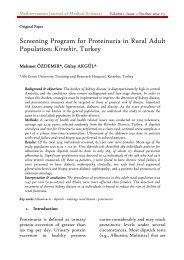Factors affecting the introduction of ICTs for ‘healthcare decision-making’ in hospitals of developing countries
Background & objectives: Several studies have evaluated the impacts of ICTs on decisionmaking process in both public and private health organizations but there is a dearth of such studies that integrate ICTs and effective decision making in Pakistan. Since the Pakistani governments continue to provide huge IT investment for its designated e-government agencies, the need to comprehend the impacts of ICTs on effective decision making becomes more important. Methods: This study strives to ameliorate the comprehension of the impacts of ICTs for decision-making process at all management levels of both public and private health organizations in Pakistan. Research on the information and communication technologies for decision-making is tabling new tools and techniques in the marketplace. Results: This study attempts to unearth literature review-based definition of the local decision-situations to help private and public sector organizations in Pakistan. Interpretation & conclusion: In the emerging ICTs environment, IT elements such as e-mail and group support facilities improve the coordination among the members of an organization in decision making. The use of these ICTs improves the organizational communication, which ultimately leads to effective decision-making Key words: ICTs; adoption factors; decision-making; healthcare; developing countries.
Background & objectives: Several studies have evaluated the impacts of ICTs on decisionmaking
process in both public and private health organizations but there is a dearth of such
studies that integrate ICTs and effective decision making in Pakistan. Since the Pakistani
governments continue to provide huge IT investment for its designated e-government
agencies, the need to comprehend the impacts of ICTs on effective decision making becomes
more important.
Methods: This study strives to ameliorate the comprehension of the impacts of ICTs for
decision-making process at all management levels of both public and private health
organizations in Pakistan. Research on the information and communication technologies for
decision-making is tabling new tools and techniques in the marketplace.
Results: This study attempts to unearth literature review-based definition of the local
decision-situations to help private and public sector organizations in Pakistan.
Interpretation & conclusion: In the emerging ICTs environment, IT elements such as e-mail
and group support facilities improve the coordination among the members of an organization
in decision making. The use of these ICTs improves the organizational communication, which
ultimately leads to effective decision-making
Key words: ICTs; adoption factors; decision-making; healthcare; developing countries.
Create successful ePaper yourself
Turn your PDF publications into a flip-book with our unique Google optimized e-Paper software.
Mediterranean Journal <strong>of</strong> Medical Sciences V1, I1 October 2014: 13-20 16<br />
date <strong>the</strong> private sector’s use <strong>of</strong><br />
<strong>in</strong><strong>for</strong>mation systems <strong>for</strong> achiev<strong>in</strong>g<br />
strategic advantages and ga<strong>in</strong><strong>in</strong>g<br />
f<strong>in</strong>ancial and bus<strong>in</strong>ess benefits is<br />
much greater than its public<br />
counterparts (Ahlan, 2005)”.<br />
Accord<strong>in</strong>g to Macleod et al. (2007)<br />
people have no participation <strong>in</strong><br />
<strong>the</strong> IS development due to<br />
concept prevail<strong>in</strong>g <strong>in</strong> public health<br />
organizations that <strong>the</strong>ir<br />
suggestions <strong>for</strong> IS development<br />
and implementations are nei<strong>the</strong>r<br />
welcomed nor enterta<strong>in</strong>ed and<br />
also <strong>in</strong>creases <strong>the</strong> time duration <strong>of</strong><br />
IS development. Similarly Certo<br />
(2001: 37-38) argues that<br />
organizational success can be<br />
enhanced by build<strong>in</strong>g appropriate<br />
relationships with <strong>the</strong> people.<br />
2.2 Executives<br />
Literature reveals that <strong>in</strong> private<br />
organizations management<br />
arranges and provides proper<br />
tra<strong>in</strong><strong>in</strong>g to <strong>the</strong> people, <strong>the</strong><br />
environment is friendlier,<br />
management has trust <strong>in</strong> <strong>the</strong>ir<br />
employees and people have<br />
respect <strong>for</strong> each o<strong>the</strong>r.<br />
Fur<strong>the</strong>rmore, results <strong>of</strong> <strong>the</strong><br />
different studies validate <strong>the</strong><br />
assertion that human <strong>for</strong>ce <strong>in</strong><br />
private health organizations is<br />
highly qualified, pr<strong>of</strong>essional,<br />
tra<strong>in</strong>ed and well experienced as<br />
well as more committed to <strong>the</strong><br />
adoption and use <strong>of</strong> IT <strong>in</strong> <strong>decision</strong><br />
mak<strong>in</strong>g process than <strong>the</strong><br />
managerial staff <strong>of</strong> public health<br />
organization ( see <strong>for</strong> example,<br />
Keri, 2007; Michel & Betty,2003);<br />
Avital, 2003).<br />
Executives are responsible <strong>for</strong><br />
overall management <strong>of</strong> <strong>the</strong><br />
organization. They establish<br />
operat<strong>in</strong>g policies and guide <strong>the</strong><br />
organization’s <strong>in</strong>teraction with its<br />
environment (Stoner and<br />
Wankle, 1986:15) and play<br />
different roles such as<br />
<strong>in</strong>terpersonal, <strong>in</strong><strong>for</strong>mational and<br />
<strong>decision</strong>al. Thus under<br />
<strong>in</strong><strong>for</strong>mation role <strong>the</strong>y are<br />
responsible <strong>for</strong> transmitt<strong>in</strong>g <strong>the</strong><br />
<strong>in</strong><strong>for</strong>mation received from outside<br />
or from o<strong>the</strong>r subord<strong>in</strong>ates to <strong>the</strong><br />
members <strong>of</strong> <strong>the</strong> organization and<br />
transmits <strong>in</strong><strong>for</strong>mation to outsiders<br />
on organization’s plans, policies,<br />
actions and results (Rob<strong>in</strong>s and<br />
Decenzo, 2006: 37). To play an<br />
<strong>in</strong><strong>for</strong>mational role successfully,<br />
executives require and make <strong>the</strong><br />
use <strong>of</strong> <strong>ICTs</strong> but our study reveals<br />
that executives <strong>of</strong> public<br />
organizations do not take <strong>in</strong>terest<br />
<strong>in</strong> <strong>the</strong> adoption and use <strong>of</strong> <strong>ICTs</strong> as<br />
p<strong>in</strong>po<strong>in</strong>ted by Ahlan (2005) that<br />
<strong>the</strong> executives <strong>in</strong> public health<br />
organizations do not take much<br />
<strong>in</strong>terest <strong>in</strong> <strong>the</strong> adoption and use <strong>of</strong><br />
<strong>ICTs</strong>, <strong>the</strong>y do not possess<br />
awareness about <strong>ICTs</strong> and have<br />
no experience <strong>of</strong> us<strong>in</strong>g <strong>the</strong> same<br />
<strong>for</strong> solv<strong>in</strong>g <strong>the</strong>ir unstructured<br />
problems.<br />
©2014 Mediterranean Center <strong>of</strong> Medical Sciences








